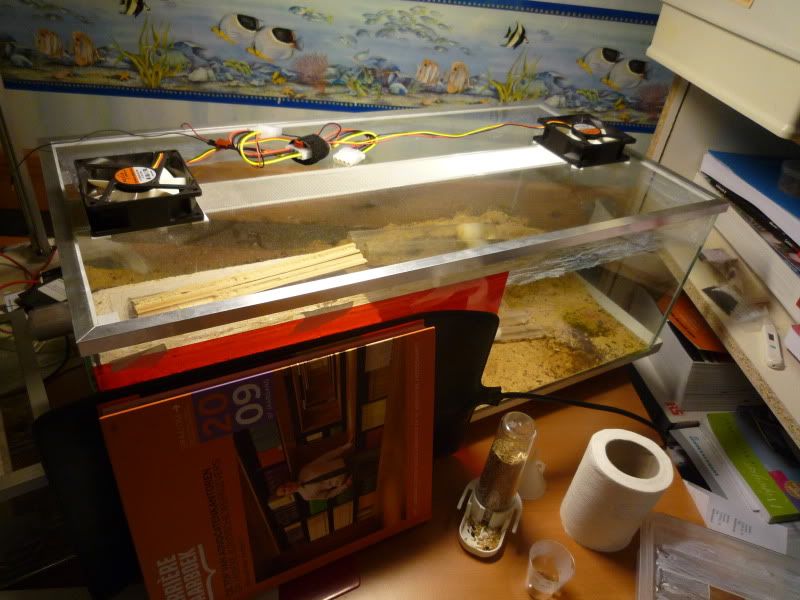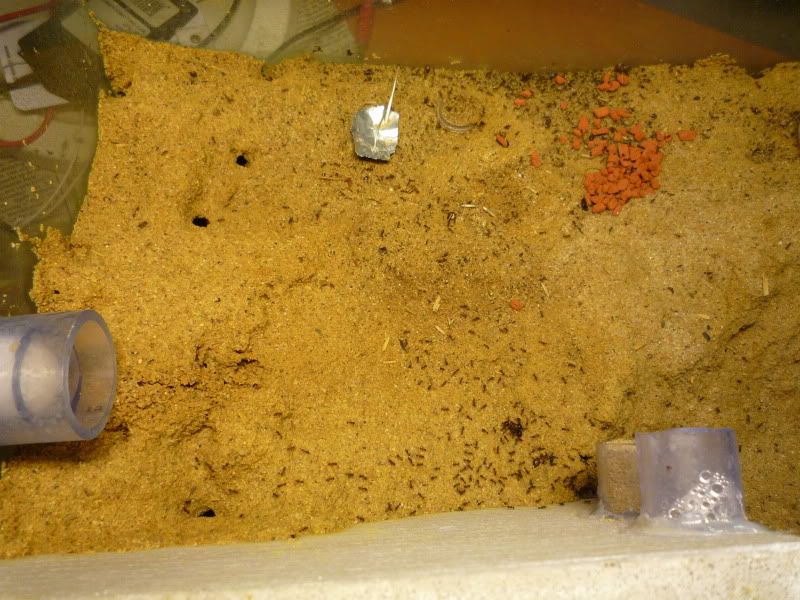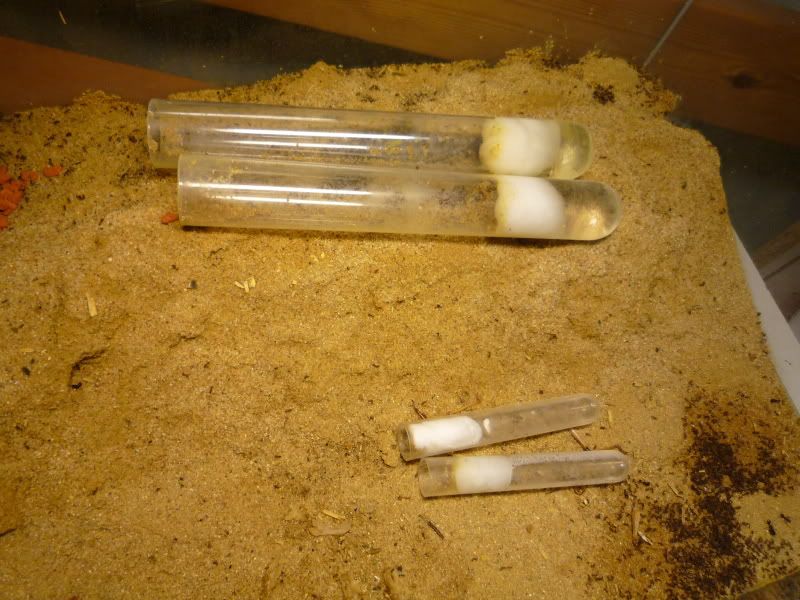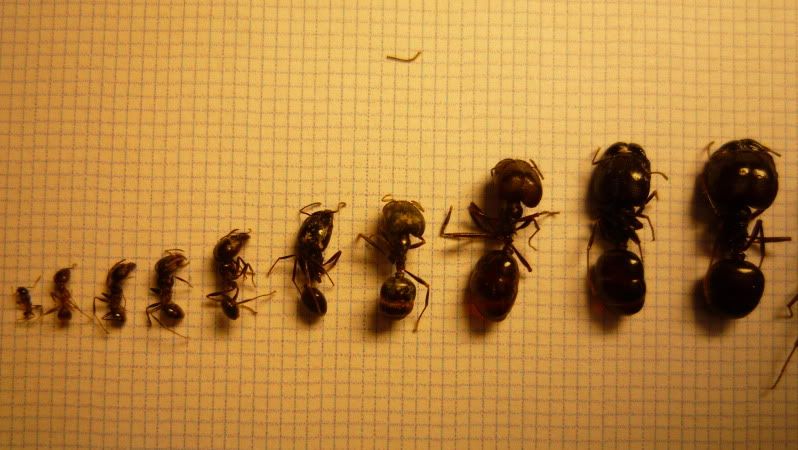Lately a lot of people showed interest in keeping the species Pheidologeton diversus. Though, most people do not know how to keep this species. With this manual i hope it will be easier for people to start with the species Pheidologeton diversus. The manual is divided in two sections. In the first section I explain how my setup works. In the second section I give some general information about the species and I will discuss several important issues which you should know before starting with this species.
Please do tell me if you see any errors, typing mistakes or if you have any suggestions.
My setup
My setup consist of a basin of 60x30x20cm and a lid. On the lid I have attached two fans and a grid. The fans improve the air circulation in the basin. With a good air circulation no water will condens on the glass. I use PTFE to prevent workers from escaping.

The nest
The nest is divided into two different nest types, a sand nest and an y-tong nest. A tunnel through the y-tong nest connects the front side of the y-tong nest with the backside of the y-tong nest which is also connected to the sand. The size of the y-tong nest is 30x20x15 cm (lxwxh). This size supports about 10.000 workers. When the y-tong nest is overpopulated, I will place a second and later, a third y-tong nest into the basin. These y-tong nests will be connected with each other with tubes. The chambers of the y-tong nest have a dimension of 6x3x2,5 cm (lxwxh). It is important to create deep and high chambers. The height is neccesary because often the workers will be hanging on the ceiling. The dept is neccesary because the brood will use a lot of space.


The sand nest consists of a mixture of sand and loam. The ratio of sand loam is about 3 : 2.

Humidity
The y-tong nest has a built-in water tank. This water tank will keep the y-tong nest humid.

Each day I spray the sand with water to keep the ground humid. It is important to keep the ground humid, because the workers can die within 24 hours in a dry environment. There are also several test tubes, which are filled with water, in the basin. When you see a pack of workers near the wet side of the cotton, you should humidify the sand. The behaviour of the workers are often a sign that their environment is to dry.

Heating
The y-tong nest is heated with a heatmat. I use a dimmer to set the temperature on 28-30 degrees Celsius. The optimal temperature can be set by observing where the workers place the brood. If the heatmat is to hot, the workers will move the brood to the backside of the chambers. I used to heat the basin with a lamp. But I did not notice any difference in activity, so I stopped heating the basin.
Pheidologeton diversus
The species Pheidologeton diversus is polygyn and polymorph. The minor workers will reach a size of 2-3 mm. The soldiers size could be between 4-18 mm. The size of the queen is about 22-24 mm. Both the workers and the queen are black coloured.

Habitat
Pheidologeton diversus is very sensitive to drought. If the environment is to dry, they could die within 24 hours. Therefore the nest should be humid at all times. The temperature should be between 22-30 degrees Celsius. The species could be kept in any nest type, as long as the nest is humid.
Development
Egg to larvae: 8-10 days
Larvae naar cocoon: 8-10 days
Cocoon of a worker: 9-12 days
Cocoon of a soldier: 30-45 days
Cocoon of a queen: 40-50 days
Cocoon of a male: 20-30 days
Food
The diet consists of either seeds and insects. Small colonies will only accept insects. Though, the common name of Pheidologeton diversus is east indian harvesting ant. Bigger colonies will also accept seeds. The diet of matured colony will consist for 50% out of seeds and 50% out of insects. The workers require only water. Though, from my own experience I can say that they also accept sugarwater.
Adoption
It is quite easy to let a colony adopt new workers or even a new queen. You place a foreign worker near a worker of the main colony and you will observe their behaviour towards each other. If they do not respond aggressively towards each other you can add more workers. Do not add soldiers to an existing colony. If something goes wrong the soldier can be a real threat to the queen.
Important issues
• If you see any workers without a gaster, then the environment is to dry.
• Minor workers only live for about one month. In this period the colony has to produce enough brood to compensate the dead workers and thus keeping the population stable.
• A colony can die within 24 hours in an environment which is to dry.
• Pheidologeton diversus can dig through y-tong.
• Soldiers need to get fed. Therefore, remove soldiers from small colonies. In a small colony the queen should get all the protein, instead of the workers.
• Most colonies in captivity die because the population of minor workers collapsed, not because of the death of the queen.
• Never buy a colony with less then 500 workers. This way you have a buffer of workers against deadly mistakes.
• Never buy a single queen. It is almost impossible to raise a colony from a single queen.
For videos about this species, visit my youtube channel:
Hyperlinks sind nur für registrierte Nutzer sichtbar
If you are interested in a colony, PM me.
Sources
Hyperlinks sind nur für registrierte Nutzer sichtbar
Ameisenforum
Hyperlinks sind nur für registrierte Nutzer sichtbar
Hyperlinks sind nur für registrierte Nutzer sichtbar
Thanks to XTof, Necturus, baumarkthammer and Erne.










